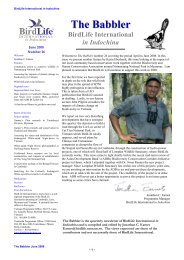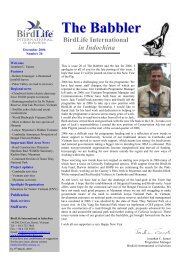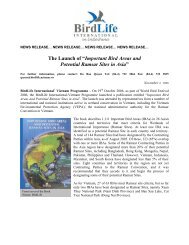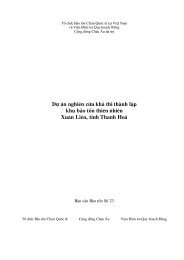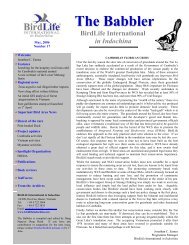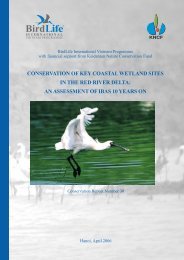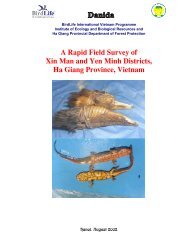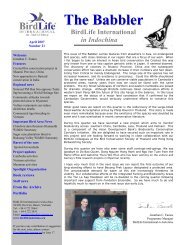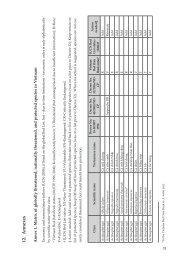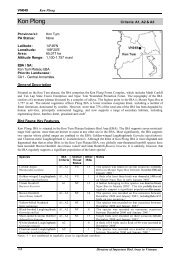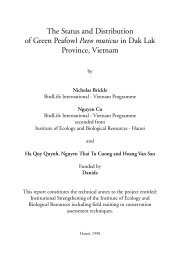A Feasibility Study for the Establishment of Xuan Lien Nature ...
A Feasibility Study for the Establishment of Xuan Lien Nature ...
A Feasibility Study for the Establishment of Xuan Lien Nature ...
You also want an ePaper? Increase the reach of your titles
YUMPU automatically turns print PDFs into web optimized ePapers that Google loves.
Section 2 - Site Features<br />
although only one specimen was obtained from local hunters. The species requires rocky, montane<br />
<strong>for</strong>est habitat, which is widespread in <strong>the</strong> area.<br />
2.11 Birds<br />
The field survey recorded 134 bird species belonging to 12 orders and 30 families in <strong>the</strong> study area. Of<br />
<strong>the</strong> 134 bird species recorded, two are listed as globally threatened (Collar et al. 1994) (Table 9).<br />
Two endemic bird species were recorded during <strong>the</strong> field survey: Short-tailed Scimitar Babbler Jabouilleia<br />
danjoui and Red-vented Barbet Megalaima lagrandieri, which are endemic to Vietnam and Laos.<br />
Table 9: Endemic and Globally Threatened Bird Species Recorded in <strong>the</strong> <strong>Study</strong> Area<br />
Species Scientific Name Endemic Current Status as per<br />
Species Collar et al. 1994<br />
Megalaimidae<br />
1. Red-vented Barbet Megalaima lagrandieri EL<br />
Sylviidae<br />
2. Short-tailed Scimitar Babbler Jabouilleia danjoui EL VU<br />
3. Short-tailed Parrotbill Paradoxornis davidianus VU<br />
Follows Inskipp et al. (1996).<br />
Notes: VU = Vulnerable as per Collar et al. (1994). EL = Endemic to Vietnam and Laos.<br />
Bird Records<br />
Great Hornbill Buceros bicornis. A group <strong>of</strong> three Great Hornbills was observed along <strong>the</strong> Ken River.<br />
The bill <strong>of</strong> a female Great Hornbill, caught in <strong>the</strong> upstream area <strong>of</strong> <strong>the</strong> Ken River, was seen in a hunter’s<br />
house.<br />
Brown Hornbill Anorrhinus tickelli. Foraging birds <strong>of</strong> this species were seen and heard at <strong>the</strong> foot <strong>of</strong> Ta<br />
Leo mountain (19 o 51’53"N 105 o 11’32'’E). Many specimens <strong>of</strong> tail and wings were found in hunters’<br />
houses in Ban Vin village.<br />
Habitat Distribution <strong>of</strong> Bird and Mammal Species<br />
The composition <strong>of</strong> <strong>the</strong> bird and mammal communities varies according to habitat type:<br />
16<br />
(a) Pure Bamboo Forest. The diversity <strong>of</strong> both mammal and bird species in this habitat is low.<br />
The only common mammals are squirrels and o<strong>the</strong>r rodents. Common birds include<br />
White-headed Babbler Gampsorhynchus rufulus, Short-tailed Parrotbill Paradoxornis<br />
davidianus, Striped Tit-babbler Macronous gularis and several species <strong>of</strong> woodpecker<br />
(Picidae). Pale-headed Woodpecker Gecinulus grantia is one <strong>of</strong> <strong>the</strong> few bird species restricted<br />
to this habitat type.<br />
(b) Mixed Bamboo and Broadleaf Evergreen Forest. Several civet species are found in this<br />
habitat, including Binturong Arctictis binturong, Masked Palm Civet Paguma larvata and<br />
Common Palm Civet Paradoxurus hermapharoditus. Common bird species include Brown<br />
Hornbill, Red-whiskered Bulbul Pycnonotus jocosus, Black-throated Laughingthrush<br />
Garrulax chinensis, Blue-winged Leafbird Chloropsis cochinchinensis and several species <strong>of</strong><br />
woodpecker and drongo (Dicrurus spp.).<br />
(c) Primary Forest. This habitat supports <strong>the</strong> greatest diversity <strong>of</strong> mammals and birds. Mammals<br />
found in this habitat type include Gaur, Asiatic Black Bear, Sun Bear, White-cheeked




